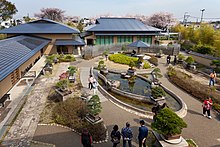Ōmiya bonsai village
The Ōmiya bonsai village ( Japanese 大宮盆栽村 Ōmiya Bonsai-mura ) is the name for a cooperative of Bonsai - nurseries in the district Kita-ku of the Japanese city of Saitama . The amalgamation of the bonsai tree nurseries also gave its name to the official place name there ( bonsai-chō , Japanese 盆栽 町 ) and is a protected designation of origin for bonsai trees from Ōmiya .
history
The founding of the village goes back to the great Kantō earthquake of 1923 . Triggered by the devastating damage in central Tokyo, many bonsai nurseries and gardeners were forced to look for an alternative location. They found what they were looking for near the city limits of Ōmiya . The land offered a wooded area, sufficient fresh water and high quality soil. After the land was acquired, they began planning a new location based on a modern infrastructure like the one in Tokyo. The first residents, mainly bonsai dealers and enthusiasts, moved into the new area in 1925. Subsequently, a cooperative was founded in 1928, in which the members support each other, but also committed to a common set of rules.
In November 1940, Ōmiya merged with the neighboring villages of Mihashi, Ōsato, Miyahara and Nisshin and thus became an independent city . The area in which the tree nurseries settled was initially known colloquially as the “bonsai village” before it was officially given this name from 1942. 2001 Ōmiya was merged with Saitama Prefecture capital Urawa to the new city Saitama, the district bonsai chō was in the appointment of a metropolis and division into districts in 2003 part of the municipality Kita ( 埼玉市北区盆栽町 , Saitama-shi Kita-ku bonsai chō ).
Since 2008, the bonsai tree nurseries in Ōmiya have officially been considered a traditional handicraft of the city of Saitama. In 2010 the Ōmiya Bonsai Art Museum was opened. It is the world's first publicly run museum for bonsai art. The museum has a collection of more than 120 bonsai trees and bonsai artifacts.
The once prosperous association of bonsai tree nurseries in Ōmiya, which in its heyday comprised up to 30 tree nurseries, only had 6 tree nurseries in 2017. The reasons given include the high real estate prices and the inheritance taxes incurred by family businesses.
Others
- The 3.miya Bonsai Festival is held in the village from May 3rd to 5th every year during the Japanese Golden Week . The event is popular among bonsai dealers and enthusiasts, so it attracts visitors not only from all over Japan but also from across Japan's borders.
- In 1963, the then Japanese Prime Minister Ikeda Hayato arranged for the then Chancellor Konrad Adenauer to be given five bonsai pots from the Ōmiya bonsai village as a gift.
See also
- Bonsai - the art of growing dwarf trees
Web links
Individual evidence
- ↑ Kan Yashiroda: Bonsai: Special Techniques . Brooklyn Botanic Garden, 1990, ISBN 978-0-945352-02-0 , p. 44
- ↑ Shōzō Kusakabe: Bonsai-chō no Tanjō . 1996 (Japanese) Retrieved April 22, 2017
- ↑ a b c Kyodo Kumiai, Nomura Michiko and Kyukaen: Bonsai-mura 80-nen no Ayumi . (Japanese) Retrieved April 21, 2017
- ^ Gather in Omiya Bonsai Village, the sacred land of bonsai - The Six Gardens . Saitama Tourism and International Relations Bureau.Retrieved April 22, 2017
Coordinates: 35 ° 55 '41.8 " N , 139 ° 37' 41.74" O

